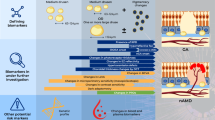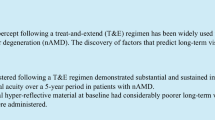Abstract
Purpose
To depict a whole spectrum of clinical feartures and visual prognosis among pediatric, adult, and elderly Vogt-Koyanagi-Harada disease (VKH) patients.
Methods
Retrospective chart review was conducted in 2571 VKH patients diagnosed from April 2008 to January 2022. Based on age of disease onset, patients were divided into pediatric (age ≤ 16 years), adult (16 < age < 65 years), and elderly (age ≥ 65 years) VKH group. Ocular and extraocular manifestations were compared among these patients. Visual outcomes and complications were evaluated using logistic regression models and restricted cubic splines analysis.
Results
The median follow-up time was 48 (IQR, 12–60) months. Pediatric, adult and elderly VKH were found in 106 (4.1%), 2355 (91.6%), and 110 (4.3%) patients, respectively. All of the patients showed similar ocular manifestations in the context of disease phasing. The proportion of neurological and auditory manifestations in pediatric (42.3% and 7.5%) VKH patients was significantly lower than that in adults (66.5% and 47.9%) and elderly (68.2% and 50%) (both p < 0.0001). An increased risk of macular abnormalities was seen in adults (OR, 3.43; 95% CI, 1.62–7.29) compared with elderly VKH. An inverted-U-shaped pattern was observed between disease onset age and a poor visual outcome (visual acuity 6/18 or worse) according to OR value in VKH patients. The highest risk of BCVA ≤ 6/18 was observed in 32 years at disease onset (OR, 1.51; 95% CI, 1.18–1.94). A higher risk of visual loss was observed in adult VKH patients (OR, 9.06; 95% CI, 2.18–37.6) compared with elderly VKH patients. And stratified by macular abnormalities, the interaction test was not significant (P = 0.634).
Conclusion
Our study identified, for the first time, a whole spectrum of clinical features of VKH based on a large cohort of Chinese patients. Adult VKH patients have an increased risk of poor visual outcomes, possibly due to increased frequency of macular abnormalities.

Similar content being viewed by others
References
Moorthy RS, Inomata H, Rao NA (1995) Vogt-Koyanagi-Harada syndrome. Surv Ophthalmol 39:265–292
Du L, Kijlstra A, Yang P (2016) Vogt-Koyanagi-Harada disease: Novel insights into pathophysiology, diagnosis and treatment. Prog Retin Eye Res 52:84–111
Yang P, Ohno S, Zierhut M (2021) Editorial: new insights into uveitis: immunity, genes, and microbes. Front Immunol 12:765377
Zhong Z, Su G, Kijlstra A et al (2021) Activation of the interleukin-23/interleukin-17 signalling pathway in autoinflammatory and autoimmune uveitis. Prog Retin Eye Res 80:100866
Tsirouki T, Dastiridou A, Symeonidis C et al (2018) A focus on the epidemiology of uveitis. Ocul Immunol Inflamm 26:2–16
Yang P, Ren Y, Li B et al (2007) Clinical characteristics of Vogt-Koyanagi-Harada syndrome in Chinese patients. Ophthalmology 114:606–614
Read RW, Holland GN, Rao NA et al (2001) Revised diagnostic criteria for Vogt-Koyanagi-Harada disease: report of an international committee on nomenclature. Am J Ophthalmol 131:647–652
Yamamoto Y, Fukushima A, Nishino K et al (2007) Vogt-koyanagi-harada disease with onset in elderly patients aged 68 to 89 years. Jpn J Ophthalmol 51:60–63
Martin TD, Rathinam SR, Cunningham ET Jr (2010) Prevalence, clinical characteristics, and causes of vision loss in children with Vogt-Koyanagi-Harada disease in South India. Retina (Philadelphia, Pa) 30:1113–1121
Marquezan MC, Nascimento H, Dalbem D et al (2020) Vogt-Koyanagi-Harada syndrome in Brazilian children. Ocul Immunol Inflamm 28:402–408
Kiyomoto C, Imaizumi M, Kimoto K et al (2007) Vogt-Koyanagi-Harada disease in elderly Japanese patients. Int Ophthalmol 27:149–153
Sadhu S, Dutta Majumder P, Shah M et al (2022) Vogt-Koyanagi-Harada disease in pre-school children. Ocul Immunol Inflamm. https://doi.org/10.1080/09273948.2022.2117707
Yang P, Du L, Ye Z (2018) How to deal with uveitis patients? Curr Mol Med 17:468–470
Yang P, Zhong Y, Du L et al (2018) Development and evaluation of diagnostic criteria for Vogt-Koyanagi-Harada disease. JAMA Ophthalmol 136:1025–1031
Yang P, Ye Z, Du L et al (2018) Novel treatment regimen of Vogt-Koyanagi-Harada disease with a reduced dose of corticosteroids combined with immunosuppressive agents. Curr Eye Res 43:254–261
Shinagawa M, Namba K, Mizuuchi K et al (2022) The steroid-sparing effect of adalimumab in the treatment for the recurrent phase of Vogt-Koyanagi-Harada disease. Ocul Immunol Inflamm. https://doi.org/10.1080/09273948.2022.2037657
Jabs DA, Nussenblatt RB, Rosenbaum JT (2005) Standardization of uveitis nomenclature for reporting clinical data. Results of the First International Workshop. Am J Ophthalmol 140:509–516
Yang P, Liu S, Zhong Z et al (2019) Comparison of clinical features and visual outcome between sympathetic ophthalmia and Vogt-Koyanagi-Harada disease in Chinese patients. Ophthalmology 126:1297–1305
Tabbara KF, Chavis PS, Freeman WR (1998) Vogt-Koyanagi-Harada syndrome in children compared to adults. Acta Ophthalmol Scand 76:723–726
Cunningham ET Jr, Demetrius R, Frieden IJ et al (1995) Vogt-Koyanagi-Harada syndrome in a 4-year old child. Am J Ophthalmol 120:675–677
Takada S, Tanaka R, Kurita N et al (2015) Vogt-Koyanagi-Harada disease in 3-year-old boy. Clin Exp Ophthalmol 43:593–594
Ikeda N, Hayasaka S, Hayasaka Y (2005) Uveitis and pseudouveitis presenting for the first time in Japanese elderly patients. Ophthalmologica J international d’ophtalmologie Int J Ophthalmol Zeitschrift fur Augenheilkunde 219:263–266
Rathinam SR, Namperumalsamy P (2007) Global variation and pattern changes in epidemiology of uveitis. Indian J Ophthalmol 55:173–183
Rathinam SR, Vijayalakshmi P, Namperumalsamy P et al (1998) Vogt-Koyanagi-Harada syndrome in children. Ocul Immunol Inflamm 6:155–161
Abu El-Asrar AM, Al-Kharashi AS, Aldibhi H et al (2008) Vogt-Koyanagi-Harada disease in children. Eye (Lond) 22:1124–1131
Yang P (2021) Atlas of Uveitis: diagnosis and treatment. People’s Medical Publishing House & Berlin, Springer, pp 295–306
Soheilian M, Aletaha M, Yazdani S et al (2006) Management of pediatric Vogt-Koyanagi- Harada (VKH)-associated panuveitis. Ocul Immunol Inflamm 14:91–98
Friedman DS, O’Colmain BJ, Muñoz B et al (2004) Prevalence of age-related macular degeneration in the United States. Arch Ophthalmol (Chicago, Ill : 1960) 122:564–72
Fox AR, Chew EY, Meyerle C et al (2017) Age-related macular degeneration in patients with uveitis. Br J Ophthalmol 101:342–347
Combadière C, Feumi C, Raoul W et al (2007) CX3CR1-dependent subretinal microglia cell accumulation is associated with cardinal features of age-related macular degeneration. J Clin Investig 117:2920–2928
Cao X, Shen D, Patel MM et al (2011) Macrophage polarization in the maculae of age-related macular degeneration: a pilot study. Pathol Int 61:528–535
Wu J, Pang S, Guo X et al (2022) Comparison of the three sets of diagnostic criteria for Vogt-Koyanagi-Harada disease in Southeast China - A retrospective case-control study. Ocul Immunol Inflamm. https://doi.org/10.1080/09273948.2022.2146592
Burgess S, Davies NM, Thompson SG (2014) Instrumental variable analysis with a nonlinear exposure-outcome relationship. Epidemiology 25:877–885
Staley JR, Burgess S (2017) Semiparametric methods for estimation of a nonlinear exposure-outcome relationship using instrumental variables with application to Mendelian randomization. Genet Epidemiol 41:341–352
Funding
This work was supported by National Natural Science Foundation Key Program (81930023), Chongqing Outstanding Scientists Project (2019), Chongqing Chief Medical Scientist Project (2018), Key Project of Chongqing Science and Technology Bureau (CSTC2021jscx-gksb-N0010), Chongqing Science & Technology Platform and Base Construction Program (cstc2014pt-sy10002) Chongqing Key Laboratory of Ophthalmology (CSTC, 2008CA5003).
Author information
Authors and Affiliations
Corresponding author
Ethics declarations
Ethical approval
This study adhered to the Declaration of Helsinki and was approved by the institutional review board of the First Affiliated Hospital of Chongqing Medical University (no. 2021–769).
Conflict of interests
The authors declare no conflict of interests.
Additional information
Publisher's note
Springer Nature remains neutral with regard to jurisdictional claims in published maps and institutional affiliations.
Supplementary Information
Below is the link to the electronic supplementary material.
Rights and permissions
Springer Nature or its licensor (e.g. a society or other partner) holds exclusive rights to this article under a publishing agreement with the author(s) or other rightsholder(s); author self-archiving of the accepted manuscript version of this article is solely governed by the terms of such publishing agreement and applicable law.
About this article
Cite this article
Yang, P., Liao, W., Pu, Y. et al. Vogt-Koyanagi-Harada disease in pediatric, adult and elderly: clinical characteristics and visual outcomes. Graefes Arch Clin Exp Ophthalmol 261, 2641–2650 (2023). https://doi.org/10.1007/s00417-023-06058-5
Received:
Revised:
Accepted:
Published:
Issue Date:
DOI: https://doi.org/10.1007/s00417-023-06058-5




